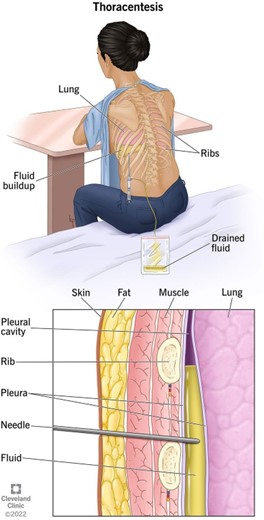A nurse is collecting data from the guardian of a toddler during a well-child visit. The guardian expresses concern to the nurse because his child has a poor appetite, but drinks a quart of milk each day.
The nurse should identify that this practice places the toddler at risk for which of the following conditions?
Celiac disease
Lactose intolerance
Acute renal failure
Iron-deficiency anemia
The Correct Answer is D
Nursing Test Bank
Naxlex Comprehensive Predictor Exams
Related Questions
Correct Answer is C
Explanation
c. "I will have a chest x-ray following the procedure."
Explanation:
The statement that indicates an understanding of the information provided is "I will have a chest x-ray following the procedure."
Explanation for the other options:
a. "I will have general anesthesia during the procedure":
This statement is incorrect. Thoracentesis is typically performed using local anesthesia, which numbs the area where the needle will be inserted. General anesthesia, which induces a state of unconsciousness, is not usually required for this procedure.
b. "I will lie flat for 6 hours following the procedure":
This statement is incorrect. While the client may be advised to lie still for a short period after the thoracentesis, it is not necessary for them to lie flat for a full 6 hours. The specific post-procedure instructions may vary depending on the client's condition and the healthcare provider's preferences.
d. "I will breathe deeply through my nose during the procedure":
This statement is incorrect. During a thoracentesis, the client is typically asked to sit upright and lean forward to allow beter access to the space between the lungs and chest wall. They may be instructed to take slow, deep breaths and hold their breath for short periods as needed during the procedure to help maintain proper positioning and reduce the risk of complications.
In summary, the statement that demonstrates an understanding of the thoracentesis procedure is "I will have a chest x-ray following the procedure." This indicates the client's awareness of the need for a post- procedure chest x-ray to evaluate the results and ensure the absence of any complications.

Correct Answer is A
Explanation
Immunocompromised individuals have a weakened immune system, which makes them more susceptible to infections. Soiled linens, when placed on the floor, can potentially harbor pathogens and become a source of contamination. It is essential to handle soiled linens properly by placing them in designated containers or bags to prevent the spread of infectious agents.
Uncapped sharps put in a puncture-resistant container: This is the correct practice for disposing of sharps, such as needles or lancets. Uncapped sharps should always be placed in puncture-resistant containers to prevent accidental injuries and potential transmission of infections.
Dampened cloths used for dusting the area: Dampened cloths for dusting can help minimize the dispersal of dust and allergens, but it does not necessarily pose a significant risk of infection.
However, it is important to ensure that the dampened cloths are properly cleaned and sanitized to prevent the growth and spread of microorganisms.
Waste containers lined with single bags: Waste containers lined with single bags are a common practice for proper waste management and disposal. While it is important to maintain good waste management practices to prevent the spread of infections, the use of single bags alone does not significantly affect the risk of infection for immunocompromised clients.
Whether you are a student looking to ace your exams or a practicing nurse seeking to enhance your expertise , our nursing education contents will empower you with the confidence and competence to make a difference in the lives of patients and become a respected leader in the healthcare field.
Visit Naxlex, invest in your future and unlock endless possibilities with our unparalleled nursing education contents today
Report Wrong Answer on the Current Question
Do you disagree with the answer? If yes, what is your expected answer? Explain.
Kindly be descriptive with the issue you are facing.
